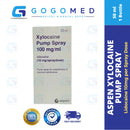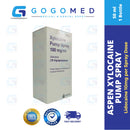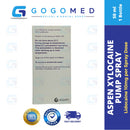









Description
Xylocaine 50ml Spray
Package leaflet: Information for the user
Xylocaine 50ml Spray
Read all of this leaflet carefully before this medicine is given to you because it contains important information for you.
- Keep this leaflet. You may need to read it again.
- If you have any further questions, ask your doctor, nurse, dentist or pharmacist.
- This medicine has been prescribed for you only. Do not pass it on to others. It may harm them, even if their signs of illness are the same as yours.
- If you get any side effects, talk your doctor, nurse, dentist or pharmacist. This includes any possible side effects not listed in this leaflet. See section 4.
What is in this leaflet:
1. What Xylocaine Spray is and what it is used for
2. What you need to know before you use Xylocaine Spray
3. How to use Xylocaine Spray
4. Possible side effects
5. How to store Xylocaine Spray
6. Contents of the pack and other information
1. What Xylocaine Spray is and what it is used for
The name of your medicine is ‘Xylocaine 10 mg Spray’. It is referred to as ‘Xylocaine Spray’ in the rest of this leaflet.
Xylocaine Spray contains a medicine called lidocaine. This belongs to a group of medicines called local anaesthetics.
Xylocaine Spray is a non-sterile solution used to numb (anaesthetise) parts of the body to reduce pain and reflex gagging:
- During medical examination of the nose, throat, stomach or lungs requiring the insertion of viewing instruments
- Minor procedures involving the nose and throat
- After childbirth.
- During treatment at the dentist.
2. What you need to know before you use Xylocaine Spray
Do not use Xylocaine Spray:
- if you are allergic to lidocaine or any of the other ingredients of this medicine (listed in section 6).
- if you are allergic to any other local anaesthetics of the same class (such as prilocaine or bupivacaine).
You must not be given Xylocaine Spray if any of the above apply to you. If you are not sure, talk to your doctor, nurse, dentist or pharmacist before you are given Xylocaine Spray.
Warnings and precautions
Talk to your doctor, nurse, dentist or pharmacist before having Xylocaine Spray:
- if you have any cuts, sores or ulcers in your throat, mouth or nose.
- if you have a chest infection.
- if you have epilepsy.
- if you have heart problems such as a slow heart beat.
- if you have very low blood pressure.
- if you have liver or kidney problems.
- if you have ever been told that you have a rare disease of the blood pigment called ‘porphyria’ or anyone in your family has it.
If you are not sure if any of the above apply to you, talk to your doctor, nurse, dentist or pharmacist before having Xylocaine Spray.
Other medicines and Xylocaine Spray
Tell your doctor or dentist if you are taking, have recently taken or might take any other medicines. This includes medicines that you buy without a prescription and herbal medicines. This is because Xylocaine Spray can affect the way some medicines work and some medicines can have an effect on Xylocaine Spray.
In particular, tell your doctor or dentist if you are taking any of the following medicines:
- Medicines used to treat an uneven heart beat (arrhythmia) such as mexiletine.
Pregnancy, breast-feeding and fertility
If you are pregnant or breast-feeding, think you may be pregnant or are planning to have a baby, ask your doctor or dentist for advice before you are given this medicine
Driving and using machines
- Xylocaine Spray may affect you being able to drive or use tools or machines. This depends on where in the body Xylocaine Spray is used and how much is used.
- Your doctor or dentist will tell you when it is safe for you to do these activities.
Xylocaine Spray contains ethanol and propylene glycol
- This medicinal product contains small amounts of ethanol (alcohol), less than 100 mg per spray.
- The banana flavouring in Xylocaine Spray contains propylene glycol. Propylene glycol may cause skin irritation.
3. How to use Xylocaine Spray
- Xylocaine Spray will usually be given to you by a doctor or dentist. The dose that your doctor or dentist gives you will depend on the type of pain relief that you need. It will also depend on your age and physical condition.
- Xylocaine spray is given using the nozzle supplied in the pack. Extra nozzles are also available separately in boxes of 50. Nozzles are single use only. The nozzles should not be re-used and should be disposed of immediately after use.
- Appropriate measures should be undertaken to avoid cross contamination in a healthcare setting including undertaking hand hygiene prior to use, use of disposable gloves during administration, keeping the box of 50 nozzles closed between procedures and ensuring disposal of each nozzle after use.
- If you are given Xylocaine Spray to take home, you must use the dose recommended by your doctor or dentist. Always use Xylocaine Spray exactly as your doctor or dentist has told you. You should check with them if you are not sure.
- Do not use more than 20 sprays in any single procedure.
- You should use as few sprays as possible.
- Do not get the spray in your eyes.
- The spray nozzle is bent so that it works properly. Do not try to change the shape of the nozzle or it might break.
How to use Xylocaine Spray in the mouth and throat
- Take care when eating or drinking following application of Xylocaine spray to the mouth or throat. When Xylocaine Spray is used in the mouth and throat it causes a loss of feeling. This makes it more likely that food or liquid may go down the wrong way. Also, this may make it difficult to swallow or cause some people to accidentally bite their tongue or cheek.
- Xylocaine Spray should be used with care in older people, in people who are in poor general health and in children.
If you use more Xylocaine Spray than you should
If you think you have used more Xylocaine Spray than you should, talk to your doctor or dentist immediately.
4. Possible side effects
Like all medicines, this medicine can cause side effects although not everybody gets them.
Severe allergic reactions (rare, may affect up to 1 in 1,000 people):
If you have a severe allergic reaction, tell your doctor immediately. The signs may include sudden onset of:
- Swelling of your face, lips, tongue or throat. This may make it difficult to swallow.
- Severe or sudden swelling of your hands, feet and ankles.
- Difficulty breathing.
- Severe itching of the skin (with raised lumps).
Other possible side effects:
- Irritation where Xylocaine Spray has been used.
- Feeling nervous.
- Feeling dizzy.
- Feeling sleepy.
- Loss of consciousness.
- Sore throat.
- Hoarse voice or loss of voice.
- Low blood pressure. This might make you feel dizzy or light-headed.
- Fits (seizures).
- Difficulty breathing or slow breathing.
- Slow heart beat.
- Stopped breathing or a stopped heart beat.
Reporting of side effects
If you get any side effects, talk to your doctor, nurse, dentist or pharmacist. This includes any possible side effects not listed in this leaflet. You can also report side effects directly via the Yellow Card Scheme at www.mhra.gov.uk/yellowcard or search for MHRA Yellow Card in the Google Play or Apple App Store. By Reporting side effects you can help provide more information on the safety of this medicine.
5. How to store Xylocaine Spray
- Keep this medicine out of the sight and reach of children.
- Do not use this medicine after the expiry date which is stated on the bottle after EXP. The expiry date refers to the last day of that month.
- Do not store above 25°C. At temperatures below 8°C the spray solution may start to go solid. This will dissolve when the spray solution is warmed up gently to room temperature.
- The nozzles should not be re-used and should be disposed of immediately after use.
- Your doctor/dentist or the hospital will normally store Xylocaine Spray. The staff are responsible for the storing, using and disposing of the spray in the correct way.
- Do not throw away any medicines via wastewater or household waste. Ask your pharmacist how to dispose of medicines you no longer use. These measures will help to protect the environment.
6. Contents of the pack and other information
What Xylocaine Spray contains
The active ingredient is lidocaine. Each dose (one spray) contains 10 mg of lidocaine.
The other ingredients are ethanol, levomenthol, macrogol 400, essence of banana (contains propylene glycol), saccharin and purified water.
What Xylocaine Spray looks like and contents of the pack
Xylocaine Spray is a clear or almost clear slightly coloured (pale pink or pale yellow) solution in a clear glass bottle with a spray pump closure. Each bottle contains 50 ml solution equivalent to about 500 sprays.
Each pack contains a single use CE-marked medical device (nozzle).
Additional spray nozzles are available separately as a pack of 50 nozzles.